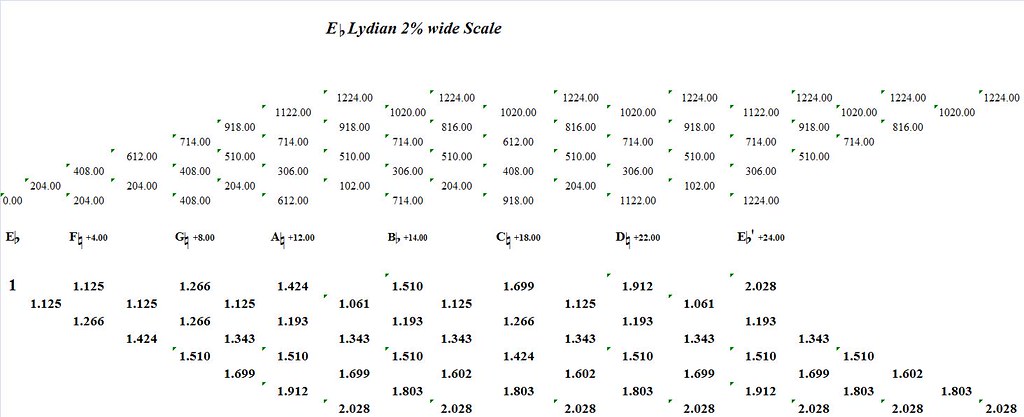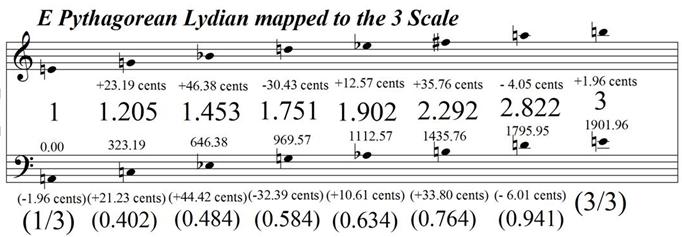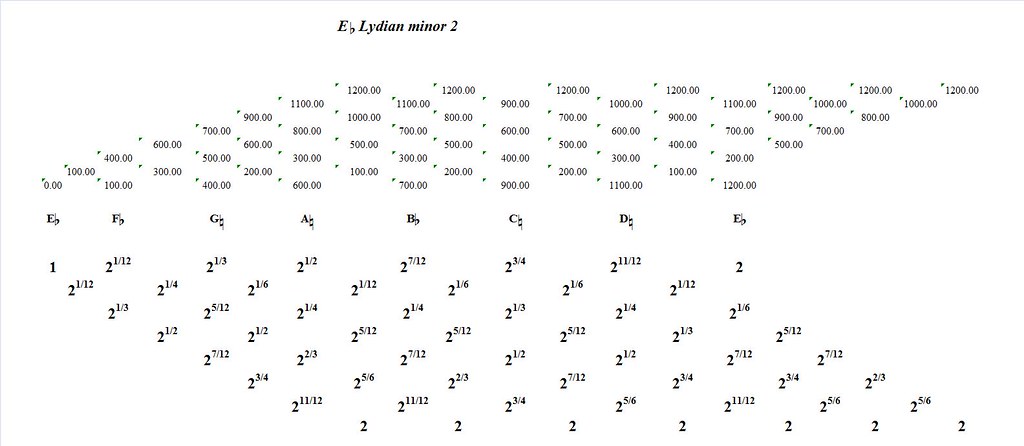
The E Lydian augmented 5 1% narrow Scale. The standard equal tempered Lydian Augmented scale compressed into a narrow octave.

 Brian Auger: Planet Earth Calling. 1981. Garland: GRZ010.
Brian Auger: Planet Earth Calling. 1981. Garland: GRZ010. Clusone Trio: An Hour With... 2000. HatHut: Hatology 554.
Clusone Trio: An Hour With... 2000. HatHut: Hatology 554. Martial Solal/Dave Douglas: Rue de Seine. 2006. CamJazz: CAM 5013.
Martial Solal/Dave Douglas: Rue de Seine. 2006. CamJazz: CAM 5013. Relache with special guests The Zs @ the Sanctuary in the Fleisher Art Memorial, Philadelphia, PA
Relache with special guests The Zs @ the Sanctuary in the Fleisher Art Memorial, Philadelphia, PA December 1952 is one of the great graphic scores by Earle Brown that blurs the line between improvisation and indeterminacy as the wide range of interpretive freedoms extended toward the performers is counterbalanced by the singular shared focus upon the visual elements of the score. The spirited interpretation offered by Relache was a tantalizingly brief glimpse of the sonic beauty such an ensemble can coax from the sparse dashes and lines found upon a sheet of paper. The second performance of this same piece - this time augmented by the Zs - was an even more stunning sonic postcard.
December 1952 is one of the great graphic scores by Earle Brown that blurs the line between improvisation and indeterminacy as the wide range of interpretive freedoms extended toward the performers is counterbalanced by the singular shared focus upon the visual elements of the score. The spirited interpretation offered by Relache was a tantalizingly brief glimpse of the sonic beauty such an ensemble can coax from the sparse dashes and lines found upon a sheet of paper. The second performance of this same piece - this time augmented by the Zs - was an even more stunning sonic postcard. Grete is a new work by Christian Wolff that was specifically commissioned by the Relache ensemble. As the final surviving member of the "New York School," Wolff is still composing new works that make use of indeterminacy. This particular performance was the highlight of the afternoon as Relache took advantage of the range of choices left to them by the composer to fashion a varied, multi-movement interpretation from the raw compositional materials as they applied a refined sense of balance and form. They also made good use of their ears as they reinforced the interdependence of the individual parts. This was a beautiful, joyous sonority that blossomed from the seeds of Living Room Music.
Grete is a new work by Christian Wolff that was specifically commissioned by the Relache ensemble. As the final surviving member of the "New York School," Wolff is still composing new works that make use of indeterminacy. This particular performance was the highlight of the afternoon as Relache took advantage of the range of choices left to them by the composer to fashion a varied, multi-movement interpretation from the raw compositional materials as they applied a refined sense of balance and form. They also made good use of their ears as they reinforced the interdependence of the individual parts. This was a beautiful, joyous sonority that blossomed from the seeds of Living Room Music.  Ludwig van Beethoven: The Complete Quartets, volume III. Performed by the Orford String Quartet in 1986. Delos: DE 3033.
Ludwig van Beethoven: The Complete Quartets, volume III. Performed by the Orford String Quartet in 1986. Delos: DE 3033. Albert Ayler: Holy Ghost [box set] disc 2. 2004. Revenant Records: 213.
Albert Ayler: Holy Ghost [box set] disc 2. 2004. Revenant Records: 213. Tim Berne: Mind over Friction (collection, the): A re-issue of the classic Science Friction Live and Studio Recordings. 2001, 2003. Screwgun: sc700018.
Tim Berne: Mind over Friction (collection, the): A re-issue of the classic Science Friction Live and Studio Recordings. 2001, 2003. Screwgun: sc700018. Bern Nix Trio @ An Die Musik, Baltimore, MD
Bern Nix Trio @ An Die Musik, Baltimore, MD

 Wayne Horvitz/4+1 Ensemble: From A Window. 2001. Disk Union: Avan 080.
Wayne Horvitz/4+1 Ensemble: From A Window. 2001. Disk Union: Avan 080. Andrew Hill: A Beautiful Day. 2002. Palmetto Records: PM 2085.
Andrew Hill: A Beautiful Day. 2002. Palmetto Records: PM 2085. Ludwig van Beethoven: Symphony No. 6 in F major (op. 68) "Pastorale". Recorded by the Royal Philharmonic Orchestra in 1993. Conducted by Mark Ermler. The International Music Company: 205298-305.
Ludwig van Beethoven: Symphony No. 6 in F major (op. 68) "Pastorale". Recorded by the Royal Philharmonic Orchestra in 1993. Conducted by Mark Ermler. The International Music Company: 205298-305.
 Ellery Eskelin: Vanishing Point. 2001. Hat Hut Records: hatOLOGY 577.
Ellery Eskelin: Vanishing Point. 2001. Hat Hut Records: hatOLOGY 577. Ornette Coleman: Sound Grammar. 2006. Sound Grammar: SG11593.
Ornette Coleman: Sound Grammar. 2006. Sound Grammar: SG11593. Giacinto Scelsi: Natura Renovatur. 2005. ECM: New Series 1963/476 3106.
Giacinto Scelsi: Natura Renovatur. 2005. ECM: New Series 1963/476 3106. Electric Junk Band @ The Atomic Stage, Hampdenfest, Baltimore, MD
Electric Junk Band @ The Atomic Stage, Hampdenfest, Baltimore, MD
 Vincent Courtois/Sylvie Courvoisier/Ellery Eskelin Trio @ An Die Musik, Baltimore, MD
Vincent Courtois/Sylvie Courvoisier/Ellery Eskelin Trio @ An Die Musik, Baltimore, MD
 2007 Guelph Jazz Festival + Colloquium
2007 Guelph Jazz Festival + Colloquium It is a credit to the vision and ideals of artistic director Ajay Heble that this small college town in southern Ontario makes a habit of hosting such a vibrant gathering each year. It's the consistency of bringing in the brightest and most exciting talents from around the world that draws in an enthusiastic and passionate audience. Many of the big city jazz festivals should take note of this consistency. The open exchange of ideas and dialogue in the accompanying colloquium fills out the music-rich experience by providing a forum for thoughtful practitioners who have a great deal to say about their art.
It is a credit to the vision and ideals of artistic director Ajay Heble that this small college town in southern Ontario makes a habit of hosting such a vibrant gathering each year. It's the consistency of bringing in the brightest and most exciting talents from around the world that draws in an enthusiastic and passionate audience. Many of the big city jazz festivals should take note of this consistency. The open exchange of ideas and dialogue in the accompanying colloquium fills out the music-rich experience by providing a forum for thoughtful practitioners who have a great deal to say about their art.
 Anthony Braxton - Diamond Curtain Wall Trio + One @ Guelph Youth Music Centre, Guelph, Ontario, Canada
Anthony Braxton - Diamond Curtain Wall Trio + One @ Guelph Youth Music Centre, Guelph, Ontario, Canada performances this past year. Very few of them are worth writing about. Anthony Braxton deftly avoided the many pitfalls this piece of software draws out from other "performers" by limiting its role to an interactive function. In effect, it added a subtle layer of resonance to the sound based upon the live input of the performers.
performances this past year. Very few of them are worth writing about. Anthony Braxton deftly avoided the many pitfalls this piece of software draws out from other "performers" by limiting its role to an interactive function. In effect, it added a subtle layer of resonance to the sound based upon the live input of the performers. Nels Cline and G.E. Stinson @ Mitchell Hall, St. George's Anglican Church, Guelph, Ontario, Canada
Nels Cline and G.E. Stinson @ Mitchell Hall, St. George's Anglican Church, Guelph, Ontario, Canada They also have a flare for mature, creative improvisation with taste as they never sustained their forays into loud territory despite having more than enough amplification at their disposal for mad plunges into pain. Their sense of dynamic contrast allowed for rich details to swirl over the long durations of their set.
They also have a flare for mature, creative improvisation with taste as they never sustained their forays into loud territory despite having more than enough amplification at their disposal for mad plunges into pain. Their sense of dynamic contrast allowed for rich details to swirl over the long durations of their set. Charlie Haden Liberation Music Orchestra featuring Carla Bley @ River Run Centre, Guelph, Ontario, Canada
Charlie Haden Liberation Music Orchestra featuring Carla Bley @ River Run Centre, Guelph, Ontario, Canada Trio M @ Guelph Youth Music Centre, Guelph, Ontario, Canada
Trio M @ Guelph Youth Music Centre, Guelph, Ontario, Canada hands down the best concert of the festival. I came away from this performance in a daze of amazement, as did much of the audience under a spell that lingered well after the last note had faded away into the ether.
hands down the best concert of the festival. I came away from this performance in a daze of amazement, as did much of the audience under a spell that lingered well after the last note had faded away into the ether. Haden Liberation Orchestra later the evening.
Haden Liberation Orchestra later the evening. Shonen Knife: Brand New Knife. 1997. MCA Victor/Big Deal: 9035-2.
Shonen Knife: Brand New Knife. 1997. MCA Victor/Big Deal: 9035-2. Brian Sacawa: American Voices. 2007. Innova: 675.
Brian Sacawa: American Voices. 2007. Innova: 675. Joe Lovano Ensemble: Streams of Expression. 2006. Blue Note Records: 946 3 41092 2.
Joe Lovano Ensemble: Streams of Expression. 2006. Blue Note Records: 946 3 41092 2. Catherine Potter - Duniya Project @ Guelph Youth Music Centre, Guelph, Ontario, Canada
Catherine Potter - Duniya Project @ Guelph Youth Music Centre, Guelph, Ontario, Canada Anthony Braxton + AIMToronto Orchestra/William Parker Ensemble @ River Run Centre, Guelph, Ontario, Canada
Anthony Braxton + AIMToronto Orchestra/William Parker Ensemble @ River Run Centre, Guelph, Ontario, Canada William Parker: composer, bass
William Parker: composer, bass Hamid Drake, in particular, was the strongest element as his intense, joy-filled drumming and Max Roach inspired solos (the performance was dedicated to the late drummer) was simply incredible to behold. It was nearly impossible not to focus on his playing throughout this performance.
Hamid Drake, in particular, was the strongest element as his intense, joy-filled drumming and Max Roach inspired solos (the performance was dedicated to the late drummer) was simply incredible to behold. It was nearly impossible not to focus on his playing throughout this performance.